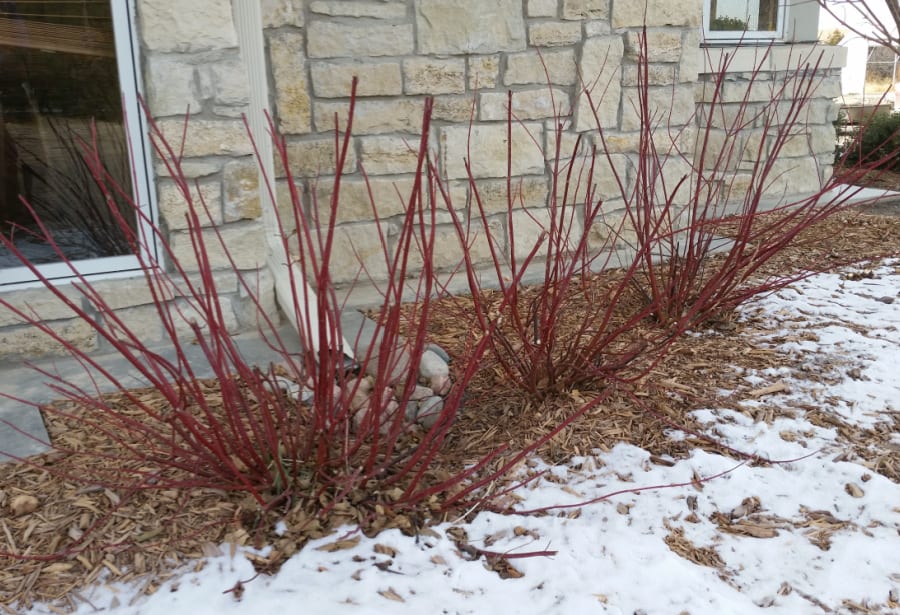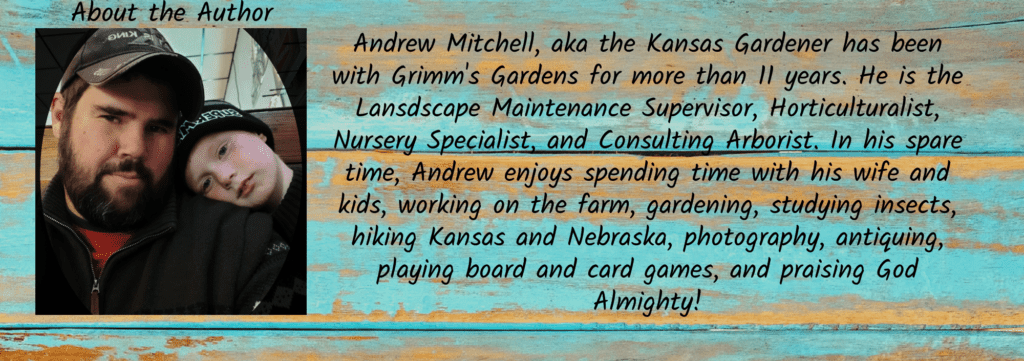Now that winter is finally upon us, I like to look at my garden and think about the future. Right now, the snow is settled over the landscape, and I can see what looks good in it. Plants for winter interest are definitely needed. But we also want plants with multiple season interest. If we design for winter alone, it may upset the balance of the landscape overall.
What plants do I already have that provide some winter interest? Ask yourself this question before you begin to think about what to add. In my own garden, there are trees with peeling bark, shrubs, grasses, and perennials. But there are gaps to fill. Yes, some of those spots might have perennials which were cut back, like hostas, iris, and daylilies. But what of the other spots?
Inventorying Your Garden
Before planning for the future, you need to know what you have. I have discussed taking an inventory of your garden before. This time, it is all about what plants make up the look of the winter garden. Make a chart similar to mine below, categorizing what you have, so you know how to complement it in the future.

You can use any method you want. Because I have so few winter interest plants in my front gardens, I just typed them up like this above. But you may want to use a spreadsheet or notepad to keep track of it all.
Adding Plants for Winter Interest
Now that you know what you have, you can begin to think about what you need. Because I already have several trees with interesting bark, I will be mainly looking for more seedheads and berries. Evergreen foliage too, is a must. Balance must be maintained between the plants of the winter garden and summer garden. You must pick plants that work together best in all seasons.
To do this properly, take photos from the same spot or angle in the garden each month, on the 15th or other day. When winter rolls around, compare the photos to see where gaps in blooming can be overcome with perennials, shrubs, grasses, or trees that add interest in all seasons, and complement the surrounding plant materials.
Sometimes, you might have a bed with large gaps between plants that provide year-round interest. I have one such bed. It is bordered with ornamental onion ‘Millenium‘, and inside that is a ring of daylilies. Then there are irises, apple trees, sedums, and hydrangeas. I have already planned to add grasses, more iris, ninebarks, and hibiscus to the center next season. Where the daylilies and irises are, there are voids in winter interest.
Types of Plants for Winter Interest
There are different features of plants that can be added for winter beauty and interest. The textures and colors of barks, berries, seedheads, and plant structure are what will add interest.
Plants with Interesting Bark for Winter
TREES
- Paperbark maple – has cinnamon colored bark, peeling. Leaves are dark green in summer and turn red/orange in autumn. It grows 30 to 40 feet tall by 25 feet wide.
- Seven son tree – has white/tan peeling bark, leaves are dark green, white flowers in late summer. Grows 15 to 25 feet tall and wide.
- Manchurian striped maple – has white/green striped bark, light green leaves that turn yellow in fall. Showy yellow flowers in spring. It grows 20 to 30 feet tall and wide.
- Birch ‘Royal Frost’ – dark purple/green leaves in summer, with slightly peeling, pure white bark. Leaves turn yellow in fall. It grows 40 feet tall by 25 feet wide.
- River birch – brown/white/cinnamon peeling bark. Has dark green leaves turning yellow in autumn. Grows 40 to 60 feet tall and wide, with many available cultivars.
- Sycamore – white/green flaking bark. Large leaves provide shade. Grows 100 feet tall and wide.
- White poplar – white bark with black lenticels. Silvery green leaves turn yellow in fall. Grows 60 feet tall by 40 feet wide. Very fast growing.
- Sassafras – has deeply ridged bark crevices. Leaves are dark green turning shades of burgundy, purple, red, and orange in fall.

SHRUBS
- Silky dogwood – has dark red stems in winter. Green leaves, white flowers and blue berries in spring to summer. Grows 10 feet tall and wide.
- Red twig dogwood – bright red stems year round, dark green leaves and white flowers. Grows 4 to 15 feet tall and wide, depending on cultivar.
- Yellow twig dogwood – golden yellow stems in winter. Dark green leaves and white flowers. 4 to 10 feet tall and wide.
- Japanese Kerria – has bright green stems all year, with dark green leaves in summer and bright yellow flowers. Prefers shade and grows 4 to 6 feet tall and wide.

Plants with Interesting Berries for Winter
- Beautyberry – has purple berries along the stem which are eventually eaten by birds. Blooms are pink on new growth. It grows 3 to 6 feet tall and wide.
- Black Chokeberry – has dark blue to black berries in winter. Shiny green leaves and pink/white flowers in summer give way to red/orange fall color. It grows 4 to 12 feet tall and wide.
- Red chokeberry – has small red berries. Shiny green leaves and white flowers. Has red fall color. Grows as a small tree 6 to 12 feet tall by 6 to 10 feet wide.
- Winterberry holly – a deciduous holly with red berries. Dark green leaves. Grows 6 to 15 feet tall and wide depending on cultivar.
- Firethorn – has brilliant orange berries. Thorny plant with green leaves turning red in fall. Grows 12 to 15 feet tall and wide.
- Smooth Sumac – has clusters of red berries. Green to yellow leaves in summer with yellow flowers. Grows in large clumps.
- Coralberry – small native shrub with pink/red berries. Leaves are green turning yellow/brown. Grows 2 to 3 feet tall in large thickets.
- Arrowwood Viburnum – has blue/black berries. Leaves are shiny green turning red in fall. White flowers in summer. Grows 5 to 15 feet tall and wide.
- Cranberrybush Viburnum – has red berries that persist into winter. Green leaves with wide clusters of white flowers. Fall color is red to maroon. Grows 8 to 12 feet tall and wide.

Plants with Interesting Seed/Flower Heads for Winter Interest
SHRUBS
- Panicle hydrangea – large spent flower heads are pretty in snow and winter. Many cultivars to choose from with different sizes and flower colors. Leaves turn yellow in fall.
- Oakleaf hydrangea – large flower heads in winter. Many cultivars to choose from for size and flower color. Leaves turn purple/red in fall.
PERENNIALS
- Ornamental onion – round seedheads, many cultivars to choose from. Flowers can be white, pink, or yellow. Great border plant.
- Echinacea species – coneflowers with tall, dark seedheads. Many cultivars for flower color and size.
- Rattlesnake master – tall native with spiky seedheads. Gray-green leaves and white flowers in summer. Grows 3 to 4 feet tall and wide.
- Tall sedum – has light brown seedheads. Many cultivars to choose from.
- Joe pye weed – has tall brown seedstalks. Pink or white flowers in late summer. Grows 4 to 6 feet tall and wide.

GRASSES
- Switchgrass – grows 3 to 10 feet tall and wide, depending on cultivar. Large seedheads.
- Indiangrass – tall native grass with feathery seedheads. Grows 6 to 9 feet tall buy 3 feet wide.
- Prairie dropseed – airy, open grass with feathery seedheads. Grows 1 to 2 feet tall and wide.
- Blue grama ‘Blonde Ambition’ – has dancing seedheads on 1 to 2 feet tall and wide plants.
- Sea oats – has interesting seedheads on thin stalks. Grows 1 to 2 feet tall and wide.
- Little bluestem – small grass with many cultivars. Grows 1 to 3 feet tall and wide.

Evergreen Plants for Winter Interest
TREES
- Colorado blue spruce – blue-green needles. There are several great cultivars. Grows 30 to 60 feet tall by 20 to 30 feet wide.
- White fir – conical tree with soft, blue-gray needles. Grows 30 to 70 feet tall by 30 feet wide.
- Douglas fir – large evergreen trees with dark green needles. It grows 60 to 100 feet tall and wide.
- Blue atlas cedar – steel blue needles with coppery upright cones. Grows 30 to 50 feet tall and wide.
- Canadian hemlock – soft green needles. It grows 30 to 50 feet tall and wide.
- Arborvitae – several species and cultivars available. Large, flat needles.
SHRUBS
- Boxwood – dark green leaves. Several cultivars and varying sizes to choose from.
- False cypress – long, needle like leaves. Can be yellow or green in color. Several cultivars to choose from.
- Yew – dark green needle like leaves. Sometimes has red berries. Several cultivars and sizes.
- Meserve holly – hybrid holly with dark green leaves and red berries on female plants. Several sizes and cultivars to choose from.

Conclusion – Enjoying Your Winter Garden
There are many ways to enjoy the garden in winter. Beside photographing the various looks of your garden, add some bird feeders, or wind catchers. Spend time watching birds and other animals in the garden. More goes on in the garden than you might think. Even in winter, there are mammals who are moving about, trying to find food and shelter.
If you have a large picture window, greenhouse, or sun room, make sure your garden is seen from those views. It may be what you see all winter. Enjoy it.
Happy planting!




